In the Northern Philippine Sea, one of the most powerful multinational naval forces currently at sea has assembled. At its heart is the Royal Navy’s HMS Prince of Wales, operating alongside Japan’s helicopter carrier JS Kaga and the U.S. Navy supercarrier USS George Washington.
They are joined by the USS America amphibious assault ship and a formidable escort screen: USS Shoup, USS Robert Smalls, JS Teruzuki, the Spanish frigate Méndez Núñez, Norway’s HNoMS Roald Amundsen, Australia’s HMAS Brisbane, and the Royal Navy’s own HMS Richmond and HMS Dauntless. Together, these 11 warships carry 23 aircraft and represent a combined strike force with the reach and firepower to operate across thousands of miles.
⚓️ In the Philippine Sea, hundreds of thousands of tonnes of allied naval power gathered. 🇬🇧 HMS Prince of Wales 🇯🇵 JS Kaga 🇺🇸 USS George Washington & more — carriers, escorts & air wings operating as one of the most powerful maritime forces afloat. #OpHighmast #CSG25 pic.twitter.com/pHgd6kLavQ
— UK Defence Journal (@UKDefJournal) August 12, 2025
A naval analyst, speaking on condition of anonymity due to other professional obligations, described the deployment as “the most powerful carrier fleet currently operating in the Pacific.” They added: “With HMS Prince of Wales at the centre, sailing alongside the U.S. supercarrier USS George Washington, Japan’s JS Kaga, and the USS America amphibious assault ship, this formation represents an unparalleled concentration of power in the region.”
On Prince of Wales’ flight deck, British and U.S. Marine Corps F-35B Lightning II jets from 809 Naval Air Squadron and VMFA-242 have landed and launched in rapid succession – a vivid demonstration of seamless integration between allied air wings. Carrier-based aviation, supported by destroyers, frigates, and amphibious assault capabilities, provides the task group with the flexibility to conduct everything from high-intensity strike operations to humanitarian missions.
The workout concluded with the UK’s flagship and her escorting destroyer HMS Dauntless putting into Yokosuka Naval Base for a three-week visit to Japan. The port call marks the latest phase of Operation Highmast, the Royal Navy’s eight-month Carrier Strike Group deployment across the Indo-Pacific.
Commodore James Blackmore, Commander UK Carrier Strike Group, said: “Operating together during the many evolutions over the past few weeks demonstrates the enhanced interoperability and the commitment of our partners and allies to the Indo-Pacific region.”
In a region where control of the seas is increasingly contested, the sight of multiple allied carriers operating together sends a clear signal: this is what maximum naval power looks like, and it is on the side of a free and open Indo-Pacific.



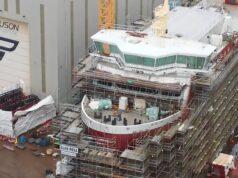

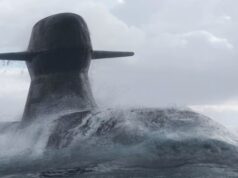
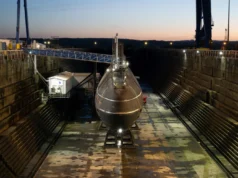
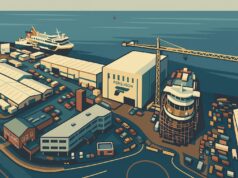



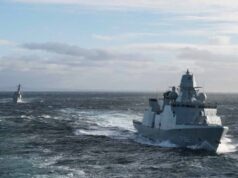
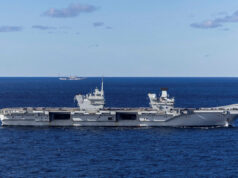

Combined 23 aircraft ……or 123 aircraft ?
And I counted 12 warships, not 11!
would be odd if neither of the US carriers had no jets onboard.
Impressed.
I’ll be honest, I expect Pravda’esque levels of reporting from the “dockyard dandy”.
This doesnt reflect reallity.
The whole is better than the sum of it’s parts.
Shocking that an America class and Queen Elizabeth class cost roughly the same amount to build, especially given the capability differences. I appreciate that US has higher labour costs, but there must be more to it than that.
Maybe we should offer to build a few QECs for the USN!
Careful….that is a Trumpian thought….serious the Tangerine Tinted one said as much…
Especially given that USS America itself has no well dock in an attempt to maximise aviation capacity, and so has no more surface connectors than the QEs.
I’m not sure how many Ospreys our carriers could carry?
They have been trialled on the QE’s (Ospreys that is) and on the Lifts, so I guess they can be carried. They do fold up rather neatly for storage.
Personally I wouldn’t get excited at having them on the Carriers, especially at the enormous cost.
Not to mention the patchy reliability and safety
I wasn’t suggesting that we purchase Osprey, just comparing the amphibious lift capability with the Americas.
Though that new unmanned one, the V-247, looks very interesting as it has a much longer range than the rest of the ‘series’.
CGI is very good these days and can cause people to forget that the V-247 has never been built and nor has its design been completed. The next real tiltrotors into production will be the MV-75 (ex-V-280) and the AW609. I’m also looking forward to the Bell-Leonardo joint offering for the “NATO” next gen rotary programme as that’s reported to be a third generation tiltrotor design. The concepts should be unveilled later this year.
US navy ships are built to much more robust standards than the QE class in regards to things like damage control and defenses. This adds a lot to the cost. The QE cost roughly 25% more than an america class (they’ve gotten cheaper as more are made, currently ~3 billion usd.
Are you sure about that?
Many of the changes and debates around the QE design, at least of those that were made public, revolved around survivability and damage control. Among other things the twin island design and the lack of azipods are both decisions based on damage control.
Defences, maybe, but how expensive are ESSM launchers really?
So 12 ships, plus whatever may be lurking in the depths…
Can I just point out that is the second US carrier group trotting around with only two major surface combatants as escorts… now I made a joke last time, but when the UK sends out a carrier with only 2 escorts people start frothing at the mouth as it’s a sign of the issues with the numbers of RN surface combatants..
But in all seriousness at last look the USN had 73 ABs and 6 Ticonderogas with those Ticos all being about 35 years old and 34 of the ABs being 25 to 34 years old and on the other side they have 10 super carriers and 27 major amphibious vessels to escort around the globe.. not including their auxiliaries that may need escorts and single deployments.. the USN is suffering badly from 1) the destruction of industrial capacity and the insanity of the littoral combat ships that lost them all their usefull frigate fleet and the zumlwalt destroyer programme.
So although it’s on a different scale to the RN the USN are suffering the same crisis of major surface combatant..
It makes you realise how serious a contribution and escort fleet of 24 combatants would be for RN @ 1/3 of USN combatant strength.
Just T32B2 needed to achieve that.
Worth a thought and not that expensive either even with Mk41 and semi quietened for a tail.
I’m sure Hugo will be along shortly to tell us to give up and go home because we currently can’t crew anything – which isn’t really true as RN have plenty of bodies but are short of WO and MO high power 6kV+ tickets.
Personally I think we should settle on a figure of 50 ships supporting 2 or maybe 3 carriers.
I think we could acelerate production to maybe 4 ships a year until we get to that figure and then replace at 2 a years on an ongoing basis.
We would also need many platforms for these automated systems which should boost the firepower 5 or 10 fold.
We need to be in a position where Europe combined can out match the US or China two or three times. The French & Germans need to match our efforts although perhaps much of the german expense might be focused on land forces.
Let’s hope both the T26 and T31 trials go particularly well.
Okay and back in the real world, gilt yields are blown out whilst taxation is smothering aggregate demand and weighing on GDP – not exactly a fiscal environment conducive to funding a massive expansion of the RN!
I’m not thinking it will really be a massive increase 20 more T31s would only cost us say 8Bn plus yes the T26 is more expensive but the more we order the less the cost per unit plus if we are committing to long term funding that should drive the cost per unit down. We have a bad habit of building small numbers at high costs.
We need to be planning high quality in decent numbers deters the enemy.
Oh and personally I doubt the British public will put up with the current shower for much longer they can’t afford their commitments on either Defence, NHS or adult care. They are completely lost. I think a change of Government is on the cards.
The reality is that building small quantities costs us at least 4 or 5 times as much. So order medium to large quantities and actually have enough to deter (which is the basis of our defensive posture). This also applies to RAF and Army. It also helps run the economy.
Yes, a bit like adding to Americas missing E7’s the UK could do well to add affordable escorts that the USN could borrow from. I have zero hope US ship building gets turned around any time soon.
The military industrial complex wants those sweet tax dollars but few places in the USA can recruit ship workers at a reasonable price and Americas admirals will never be able to stop themselves gold platting the toilets on their destroyers.
A fraction of their budget spent in South Korea woukd get them a fleet of Aegis equipped destroyers to serve as an interim capability but it’s too politically toxic. They can’t even buy missiles from the UK so foreign warships are a total no go.
T32 B2 ?
My god, It’s bad enough waiting for the mytical T32 as it is, let alone a B2 ! 😁
Sorry that was meant to read T31BII – but I think you knew that!
Building more T31 isn’t a budget budget on 3.5% if it is every delivered and many subs the Hi Lo mix to balance off T26 and T45 which is 14 hulls.
River B1s are going and should be replaced with GP hulls as we need mass to send to war.
I did, hence the big cheesy grin !
I would like to see all the T45’s, Astutes and remaining T23’s actually able to “get out there”. I’d also love to see a real increase in numbers accross the board too.
I think we have to be realistic that T23s are EOL.
Personally I’m more concerned about Daring getting back to sea and seeing all six T45 with NSM and Sea Ceptor and T31 with NSM and Mk41.
Then getting our precious SSNs back to Sea.
The next problem is buying stuff for the Mk41 slots!
Has RN contemplated restoring/upgrading the bow sonar of T-45? Perhaps Jerry rigging a tail? Needs must for an interim ASW capability…🤔
Sonar on T45 is a non event (& considering UK reputation on all things ASW is not a good look). T31 continues this bad look. Hopefully a T31 B2 puts back at least the IH ASW ability (which Babcock assures everyone still exists but has a price tag attached).
PS: get rid of the 57mm!
I hear what you are saying, but there are likely plenty of other US assets is the near vicinity that could supplement their CSGs at short notice. The UK could get away with this is its own backyard too (North Atlantic, Mediterranean); but it’s different when you are sending the bulk our your active firepower to the other side of the world with a view to provoke (maybe too strong a word) semi-hostile countries. The UK doesn’t have any / many other sovereign assets in the area that could be called upon at short notice.
The one thing UK has, that US does not have is connections (or rather positive connections). Trump is burning more bridges than he is building & they never had as many bridges as they thought they had to start with.
Reality is hard to deal with… Maybe you should start trying a little harder. It’s not 1939. Anymore?
The current AB Flight III contract is slated to deliver 2 ships a year. That’s 12 years just to build the III’s they have planned. They may add more, so most likely more Flight I and II will see their service extended beyond their 35 years expected lives.
The next III contract has surely got to speed things up or the USN will see a drastic reduction in destroyer numbers.
DDG(X) is currently slated for construction in 2032. It would be a miracle if any enter service before 2035. Their remaining Ticos are going to be fossils by the time they are replaced, assuming they make it that far.
All the while China builds their escort fleet at alarming rates.
What is really worrying is it’s not just the major surface combatants, it’s also the SSN fleet.. the US is meant to have 66 SSNs but by 2030 they are likely to have 46 as the LAs all retire out and they seem unable to build more than 1.2- 1.5 SSNs a year.
All the while it looks like china has moved its SSN production capacity up to about 4-6 a year, with another hall on the way… yes China has a low base line, but it’s finally cracked its reactor density issue and most people agree the type 95 will be competitive if not quite a peer… add that production to chinas 50-60 decent AIP/electric boats and 10 type 93/A/B variants ( with likely another 8 or so on the way, before the type 95 is launched).
Very alarming, although the USN is trying to increase their production rate to 2 by 2028, then potentially 2.33. They are very much relying on their qualitative edge.
Slightly side tracking: But it’s much easier to build a new fleet than to maintain and upgrade an existing large fleet. “We want a big blue water navy” just build a lot of dockyards and massively surge capacity, and then leave how those dockyards remain viable in the future to the future goverment to worry about. It’ll be interesting to see how China manages when their new build fleet starts aging out and they have to pay to support maintenance and upgrades as well as putting new replacement hulls in the water.
That’s true, but it will give China an optimum time to make any moves it is planning. While their own fleet is still young and the USN hasn’t rebuilt. Not that I think the US will intervene anyway.
Of course, but it’s always something worth bearing in mind with China’s rapid expansion.
Building two destroyers a year won’t keep them in the major league navies for very long.
And the UK can’t put one SSN to see at the moment and the availability of the destroyers is maybe one or two at best.. let’s not cock off shall we?
And the USN design saga continues w/ the Consternation Class…🤔😳😱☹️
Don’t they technically have 11 supercarriers if you include the Gerald Ford. I know Nimitz has just about had it’s moment and will be scrapped soon but the Ford Class is building momentum and the replacement of all the Nimitz class carriers should be phased in over the next couple of decades maybe.
Unfortunately the reverse has become true, Ford class procurement is slowing down. The next two just got delayed by a further two years with Enterprise the third carrier not due until 2030.
They will now drop to 10 carriers by the end of the decade and there is till no plan to get the F35C on to the first two Ford Class yet and maybe the third.
Now FA/XX has been cancelled we may see the US carriers going the way of AWACS. I think a like for like replacement of Ford Class and Nimitz is unlikely now. Maybe dropping down to 6 super carriers and more America class is a good idea for them.
Interesting. Perhaps the plan is for the US to massively cut defence spending to fund tax cuts. I suspect that might backfire.
“and there is till no plan to get the F35C on to the first two Ford Class yet and maybe the third.”
Hi Jim,
Some factual errors.
While the Ford class has indeed suffered slow build times, the second (John. F. Kennedy) and subsequent ships in the class will be completed with F-35C capability at commissioning. F-35C equipment was called out on the FY 25 budget (over a year ago) for the Gerald R. Ford, so plans are very much in place for fitting the Ford with 5th gen capability, I suspect it will happen after the ship’s current deployment.
Far more speculatively, FA/XX has recently garnered more support in the Senate, and “might” still make the cut, time will tell.
AFAIK FA/XX has faced cuts and less support than F47, but is currently being given further support and funding by congress – there’s a bill. It certainly hasn’t been cancelled
Last I heard the official requirement was for 12 ships, but as Jim observes, the achievable build rate versus the scheduled retirement of older ships is going to make it impossible to meet that requirement any time soon.
I heard the same. They get about 25% time on station (around 30% at sea), and they want to have three on station before any surge, to be dealing with three situations. Hence the need for twelve carriers. They can’t build them fast enough.
I am a long time advocate of them having a split of eight large nuclear and six not quite so large conventional. They can build conventional CATOBAR carriers in several sites, but nuclear ones can only be built at Norfolk News, and the headlines will tell you why they can’t build those as fast as they need. They have similar issues maintaining nuclear carriers. There are also severe limitations of where nuclear carriers are welcome, and the only place outside the US that will base them is Japan.
Conventional carriers of the size of the QE (or slightly larger) can carry/launch maybe half the number of planes of the Nimitz class. So logically they’d need two to replace a Nimitz. However, they’d get a lot more on station time out of conventional as they could forward base it somewhere like Greece. So if they could raise on-station time to 33% by forward basing two 75,000 ton conventional carriers in Europe (in the same way they currently do at Yokosuka), they could keep the power projection of a single Nimitz permanently on station using only 6 medium/large conventional carriers as opposed to 4 large nuclear ones.
The way the Americans build carriers, each would cost them considerably more than we paid for a QE class, not only because of the extras that come with CATOBAR, but because they don’t allow rendundancy to take the load of survivability, so build to much more exacting survivability standards. It would probably cost them between 60% and 65% to get something half as effective. That sounds like a bad deal until you figure in the on-station percentage increase, which brings the cost back to roughly parity.
However, in terms of achievability, it’s streets ahead of relying solely on large nuclear. There is no robustness/resillience in the Ford-class build and maintenance programmes at the moment, and if anything happens to reduce build times at that one site in Virginia, such as recruitment or training issues, the carrier programme currently suffers automatic delays that they just have to grin and bear.
I think the Americans would dispute the hyperbole of this article.
However, the Mogami has had me thinking, is there any merit in a lend lease arrangement on T31 – NZ might take four and there are other nations who might be interested while bringing sales and reducing costs through scale. Just a thought.
I’m not convinced we can grow our manufacturing base to support our own navy much less large scale exports. Even the poorest areas in Britain like barrow have labour shortages.
We are near full employment and most people want to work in services. All the same issues the USA has.
We don’t invest sufficiently in tech so our manufacturing productivity is pants. This is reversible with more incentives.
NZ may consider A140, but a T31? I doubt even Babcock would be willing to put their name to such an offer. Currently, T31 can’t compete with NZ existing 25 year old frigates.
…but what is the striking power of all those aircraft? Are they bristling with ASHM or just bombs?
Is the only strike capability resting on missiles aboard the ships, or on the ?? Number of nukes accompanying the fleet.
AA
The F18 can carry LRASM and AGM-84H/K SLAM-ER. Both long range weapons. Harpoon too, but I don’t know if they have been replaced by the former.
I don’t think many weapons have been integrated on the F35C yet, not stand off ASM anyway. Same for our Bs.
So the long range strike power sits primarily with the F18s and two ABs with their Tomahawks. One would assume there is at least one SSN.
Most of the other escorts carry ASM, a mixture of Harpoon, NSM, and Type 90. All with similar range.
The UK CSG is now much shrunken, all allied vessels except the Norwegian frigate Roald Amundsen having reverted to national control and headed off on other taskings. The USN will again [embarrassingly] have to escort the CSG when it transits high risk areas such as the South China Sea and Red Sea. After an assisted maintenance period, the CSG leaves Japan and Korea on 2 September to sail back down to the Malaysia/Singapore area for Exercise Bersama Lima 2025. After that, homeward bound, baring a final exercise in the Med which is probably the last thing the crews and air group will want by that stage. I expect that many of the F-35B’s will then disembark and hurry back to Marham, rather remain on PoW for the last week of the deployment.
Sometimes you have to ask rather than expect volunteers. Even if all that is offered is a PB, never turn it down. For some nations that is all they have. It builds a picture. UK cannot operate in the Indo-Pacific on its own. Everyone knows that.